小学一年级英语:Unit 1教学设计
- 格式:docx
- 大小:108.08 KB
- 文档页数:16

Module 1 Unit1 I want a hot dog, please.教学设计一、课型新授课二、指导思想与理论依据《英语课程标准》指出,英语教学应该以学生为主体,首先要培养学生的学习兴趣、信心、策略和习惯;强调课程从学生的学习兴趣和认知水平出发,倡导体验、参与、合作与交流的学习方式,发展学生的综合语言运用能力。
《英语课程标准》同时指出,教师在教学中应初步渗透拼读规律、学习策略等,发展学生的自主学习能力。
三、教学背景分析(一)教材分析本节课的教学内容是外研社新标准英语(供一年级起始用)六下Module1Unit1,本单元以就餐为话题,呈现了Daming 和Simon 跟随Simon's dad 去一家快餐店就餐的情景。
本单元的语言功能是如何在快餐店点餐和如何询问价钱。
本课的内容贴近学生的生活实际,有利于培养学生在真实的语言情景中运用英语进行交际的能力。
本课内容在整个英语学科的教学中起着承上启下的作用,三年级上学期Module1 对Do you want…?这一句型结构进行了学习,在一年级上学期Module8 ,一年级下学期Module3 ,三年级下学期Module1,Module4,Module7 等模块进行了数字的学习,在六年级上学期Module5 对I want a…这一句型结构进行了学习,Module9 对Do you want to…? I want to… 句型进行了学习,本单元又进行“ What do you want? I want …, please. How much is it? It's….句型的学习,这是对前面所学知识的一种复习巩固,也是一种承接;本节课后一个单元也是学习如何在快餐店点餐和如何询问价钱,对本课句型进行了复习运用,从这里讲,本单元对该句型的复习巩固为后面的学习做好了铺垫,起到了启下的作用。
(二)学情分析本课的授课对象是六年级的学生,他们的抽象思维已经有所发展,但仍以形象思维为主,第二信号系统开始占优势,求知的欲望和能力,好奇心都有所增强,对新鲜事物开始思考、追求、探索。

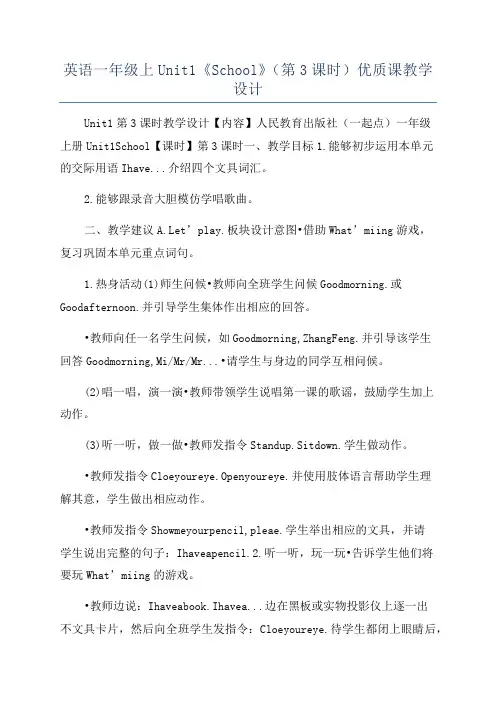
英语一年级上Unit1《School》(第3课时)优质课教学设计Unit1第3课时教学设计【内容】人民教育出版社(一起点)一年级上册Unit1School【课时】第3课时一、教学目标1.能够初步运用本单元的交际用语Ihave...介绍四个文具词汇。
2.能够跟录音大胆模仿学唱歌曲。
二、教学建议A.Let’play.板块设计意图•借助What’miing游戏,复习巩固本单元重点词句。
1.热身活动(1)师生问候•教师向全班学生问候Goodmorning.或Goodafternoon.并引导学生集体作出相应的回答。
•教师向任一名学生问候,如Goodmorning,ZhangFeng.并引导该学生回答Goodmorning,Mi/Mr/Mr...•请学生与身边的同学互相问候。
(2)唱一唱,演一演•教师带领学生说唱第一课的歌谣,鼓励学生加上动作。
(3)听一听,做一做•教师发指令Standup.Sitdown.学生做动作。
•教师发指令Cloeyoureye.Openyoureye.并使用肢体语言帮助学生理解其意,学生做出相应动作。
•教师发指令Showmeyourpencil,pleae.学生举出相应的文具,并请学生说出完整的句子:Ihaveapencil.2.听一听,玩一玩•告诉学生他们将要玩What’miing的游戏。
•教师边说:Ihaveabook.Ihavea...边在黑板或实物投影仪上逐一出不文具卡片,然后向全班学生发指令:Cloeyoureye.待学生都闭上眼睛后,教师拿走其中的一张卡片。
再发指令:Openyoureye.What’miing请学生观察并说出被拿走图片的英文名称。
•教师将图片打乱顺序,重复玩这个游戏。
直到所有学生能够听懂指令语:Cloeyoureye.Openyoureye.What’miing为止。
3.小组活动(1)师生示范•教师请三名学生到前面,配合教师向全班学生做示范。
游戏说明:学生四人一组活动。
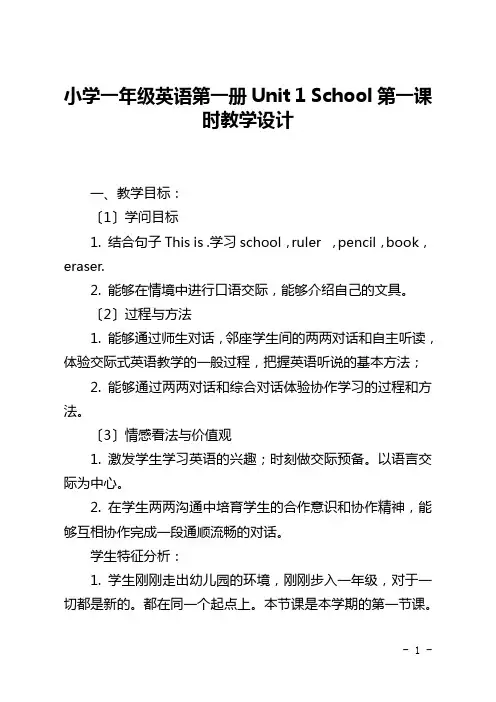
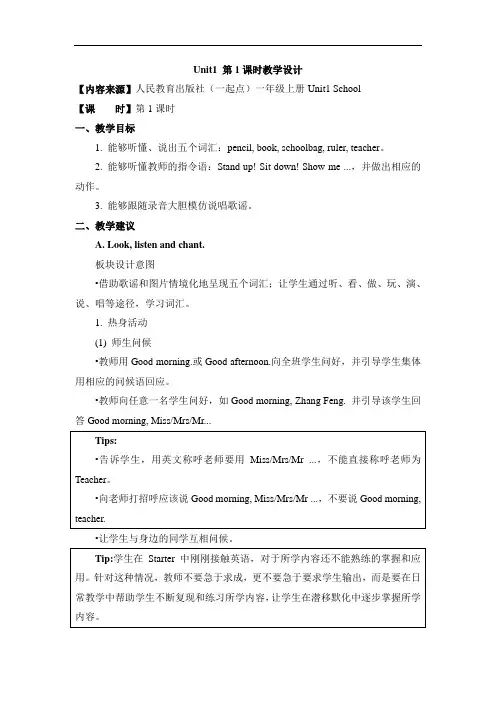
Unit1 第1课时教学设计【内容来源】人民教育出版社(一起点)一年级上册Unit1 School【课时】第1课时一、教学目标1. 能够听懂、说出五个词汇:pencil, book, schoolbag, ruler, teacher。
2. 能够听懂教师的指令语:Stand up! Sit down! Show me ...,并做出相应的动作。
3. 能够跟随录音大胆模仿说唱歌谣。
二、教学建议A. Look, listen and chant.板块设计意图•借助歌谣和图片情境化地呈现五个词汇;让学生通过听、看、做、玩、演、说、唱等途径,学习词汇。
1. 热身活动(1) 师生问候•教师用Good morning.或Good afternoon.向全班学生问好,并引导学生集体用相应的问候语回应。
•教师向任意一名学生问好,如Good morning, Zhang Feng. 并引导该学生回答Good morning, Miss/Mrs/Mr...•让学生与身边的同学互相问候。
(2) 听一听,做一做•教师发指令语Stand up. Sit down. 并用手势和动作帮助学生理解其意,要求学生能听懂并做出反应即可。
2. 呈现新的学习内容(1) 出示挂图,初步感知新语言•引导学生观察“开篇页”挂图中描绘的内容,并用中文说一说这是什么地方?学生在干什么?引出本单元的主题“School”。
•向学生介绍七个主线人物:Andy, Bill, Binbin, Joy, Lily, Yaoyao和Miss Wu,并引导学生使用此前学到的问候语,如Good morning. Good afternoon.或Hello.等与主线人物打招呼。
•教师指着图中Miss Wu说:Miss Wu is a teacher. 再指着自己说:I am a teacher.重复2-3遍,帮助学生把教师这个人物和英文表达teacher建立联系。
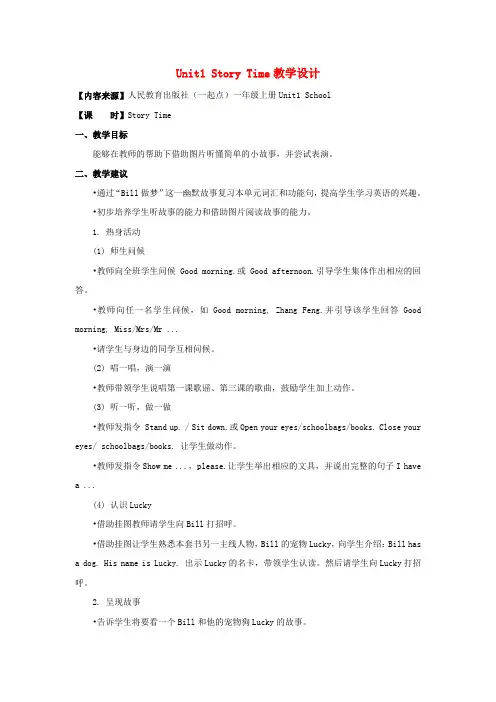
Unit1 Story Time教学设计【内容来源】人民教育出版社(一起点)一年级上册Unit1 School【课时】Story Time一、教学目标能够在教师的帮助下借助图片听懂简单的小故事,并尝试表演。
二、教学建议•通过“Bill做梦”这一幽默故事复习本单元词汇和功能句,提高学生学习英语的兴趣。
•初步培养学生听故事的能力和借助图片阅读故事的能力。
1. 热身活动(1) 师生问候•教师向全班学生问候Good morning.或Good afternoon.引导学生集体作出相应的回答。
•教师向任一名学生问候,如Good morning, Zhang Feng.并引导该学生回答Good morning, Miss/Mrs/Mr ...•请学生与身边的同学互相问候。
(2) 唱一唱,演一演•教师带领学生说唱第一课歌谣、第三课的歌曲,鼓励学生加上动作。
(3) 听一听,做一做•教师发指令 Stand up. / Sit down.或Open your eyes/schoolbags/books. Close your eyes/ schoolbags/books. 让学生做动作。
•教师发指令Show me ...,please.让学生举出相应的文具,并说出完整的句子I havea ...(4) 认识Lucky•借助挂图教师请学生向Bill打招呼。
•借助挂图让学生熟悉本套书另一主线人物,Bill的宠物Lucky,向学生介绍:Bill has a dog. His name is Lucky. 出示Lucky的名卡,带领学生认读。
然后请学生向Lucky打招呼。
2. 呈现故事•告诉学生将要看一个Bill和他的宠物狗Lucky的故事。
•将故事挂图贴在黑板上,给学生几分钟时间看挂图。
让学生两人一组,讨论图片内容,说一说自己对故事的理解。
•教师完整地播放故事录音,或从头至尾讲故事,让学生认真听,验证刚才的猜测是否准确。
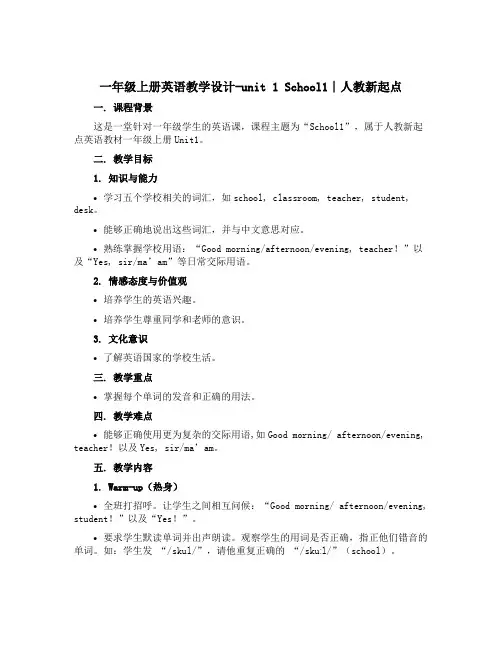
一年级上册英语教学设计-unit 1 School1∣人教新起点一. 课程背景这是一堂针对一年级学生的英语课,课程主题为“School1”,属于人教新起点英语教材一年级上册Unit1。
二. 教学目标1. 知识与能力•学习五个学校相关的词汇,如school, classroom, teacher, student, desk。
•能够正确地说出这些词汇,并与中文意思对应。
•熟练掌握学校用语:“Good morning/afternoon/evening, teacher!”以及“Yes, sir/ma’am”等日常交际用语。
2. 情感态度与价值观•培养学生的英语兴趣。
•培养学生尊重同学和老师的意识。
3. 文化意识•了解英语国家的学校生活。
三. 教学重点•掌握每个单词的发音和正确的用法。
四. 教学难点•能够正确使用更为复杂的交际用语,如Good morning/ afternoon/evening, teacher!以及Yes, sir/ma’am。
五. 教学内容1. Warm-up(热身)•全班打招呼。
让学生之间相互问候:“Good morning/ afternoon/evening, student!”以及“Yes!”。
•要求学生默读单词并出声朗读。
观察学生的用词是否正确,指正他们错音的单词。
如:学生发“/skul/”,请他重复正确的“/skuːl/”(school)。
2. Presentation(呈现)•在黑板上展示单词并读出来,让学生跟读,随后要求学生分组展示单词卡片,每组一人拿卡片出示单词,并让其他小组学生说出中文意思,如此轮流展示。
3. Practice(练习)•模拟对话练习。
老师会问:“How are you?”,要求学生回答“Y es, I am fine, thank you, and you?”,老师再回答“Yes, I am fine, too.”,要求同学对话演练并互相检查对话内容的正确性。
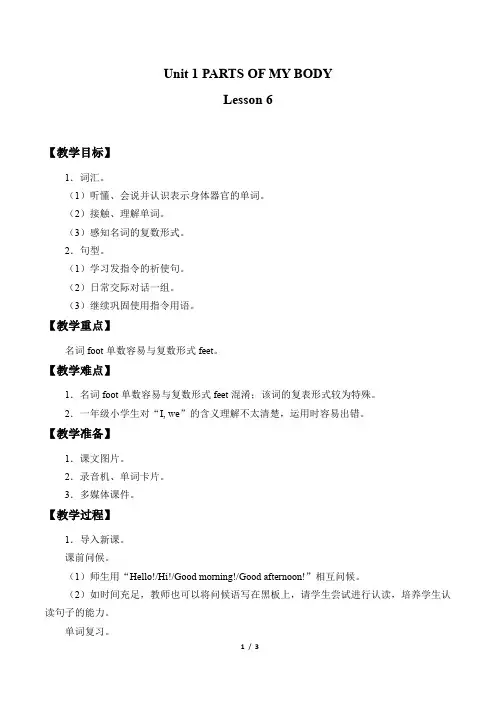
Unit 1 PARTS OF MY BODYLesson 6【教学目标】1.词汇。
(1)听懂、会说并认识表示身体器官的单词。
(2)接触、理解单词。
(3)感知名词的复数形式。
2.句型。
(1)学习发指令的祈使句。
(2)日常交际对话一组。
(3)继续巩固使用指令用语。
【教学重点】名词foot单数容易与复数形式feet。
【教学难点】1.名词foot单数容易与复数形式feet混淆;该词的复表形式较为特殊。
2.一年级小学生对“I, we”的含义理解不太清楚,运用时容易出错。
【教学准备】1.课文图片。
2.录音机、单词卡片。
3.多媒体课件。
【教学过程】1.导入新课。
课前问候。
(1)师生用“Hello!/Hi!/Good morning!/Good afternoon!”相互问候。
(2)如时间充足,教师也可以将问候语写在黑板上,请学生尝试进行认读,培养学生认读句子的能力。
单词复习。
(1)利用图片、单词卡片快速复习学过的关于身体器官的单词。
(2)进行关于身体器官单词单数、复数的识记检测,例如:看图说词,听音做动作,听音指词,听指令做动作等。
(3)复习上节课学习的歌曲,通过齐唱、小组唱、个人唱等达到充分练习,为本节课的歌曲学习奠定基础。
2.听一听,看一看,说一说。
感知单词foot和feet。
(1)教师表扬学生歌曲唱得好并播放本课的歌曲录音。
教师随着歌词做动作,之后问学生“What will you do if you are happy? When do I do when I listen to the song?”。
(2)学生说出教师在跺脚。
教师点头表示肯定,并重复说几遍“Stamp feet! Stamp feet! Stamp feet!”。
请学生说出这首歌提到了哪个身体器官。
(3)学生会说“脚”。
教师马上说“Yes. Feet.”并且指着第一项活动中foot和feet的图说“foot-feet.”。
操练单词。
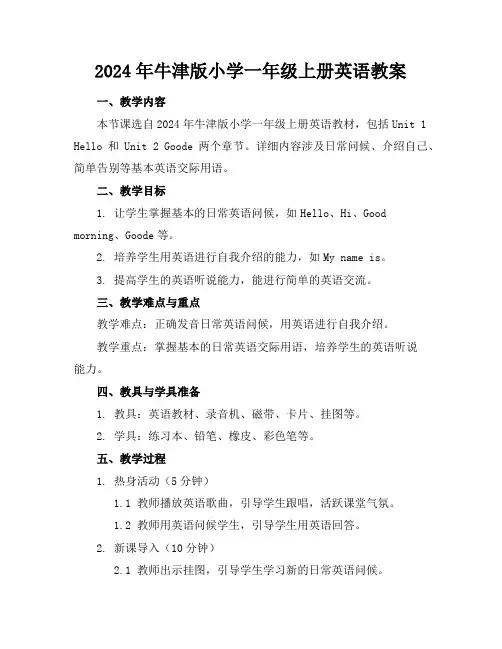
2024年牛津版小学一年级上册英语教案一、教学内容本节课选自2024年牛津版小学一年级上册英语教材,包括Unit 1 Hello和Unit 2 Goode两个章节。
详细内容涉及日常问候、介绍自己、简单告别等基本英语交际用语。
二、教学目标1. 让学生掌握基本的日常英语问候,如Hello、Hi、Good morning、Goode等。
2. 培养学生用英语进行自我介绍的能力,如My name is。
3. 提高学生的英语听说能力,能进行简单的英语交流。
三、教学难点与重点教学难点:正确发音日常英语问候,用英语进行自我介绍。
教学重点:掌握基本的日常英语交际用语,培养学生的英语听说能力。
四、教具与学具准备1. 教具:英语教材、录音机、磁带、卡片、挂图等。
2. 学具:练习本、铅笔、橡皮、彩色笔等。
五、教学过程1. 热身活动(5分钟)1.1 教师播放英语歌曲,引导学生跟唱,活跃课堂气氛。
1.2 教师用英语问候学生,引导学生用英语回答。
2. 新课导入(10分钟)2.1 教师出示挂图,引导学生学习新的日常英语问候。
2.2 教师示范发音,学生模仿跟读,并进行小组练习。
2.3 教师邀请学生上台进行自我介绍,引导学生用英语表达。
3. 实践情景引入(15分钟)3.1 教师创设情景,如学校门口、教室等,引导学生用英语进行问候和告别。
3.2 学生分组进行角色扮演,练习日常英语交际用语。
4. 例题讲解(10分钟)4.1 教师出示例题,如:Hello, my name is Tom. What's your name?4.2 教师讲解句型结构,引导学生模仿并练习。
5. 随堂练习(10分钟)5.1 教师发放练习纸,学生完成练习。
5.2 教师对练习进行讲解,纠正学生的错误。
6.2 布置作业。
六、板书设计1. 板书课题:Unit 1 Hello & Unit 2 Goode2. 板书内容:日常英语问候、自我介绍、告别等句型。
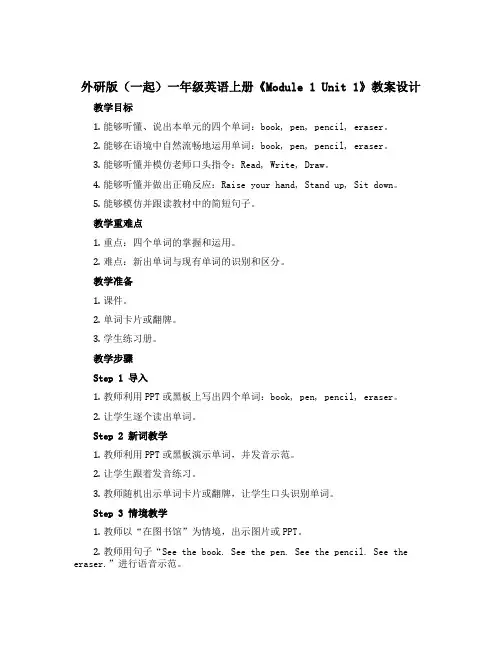
外研版(一起)一年级英语上册《Module 1 Unit 1》教案设计教学目标1.能够听懂、说出本单元的四个单词:book, pen, pencil, eraser。
2.能够在语境中自然流畅地运用单词:book, pen, pencil, eraser。
3.能够听懂并模仿老师口头指令:Read, Write, Draw。
4.能够听懂并做出正确反应:Raise your hand, Stand up, Sit down。
5.能够模仿并跟读教材中的简短句子。
教学重难点1.重点:四个单词的掌握和运用。
2.难点:新出单词与现有单词的识别和区分。
教学准备1.课件。
2.单词卡片或翻牌。
3.学生练习册。
教学步骤Step 1 导入1.教师利用PPT或黑板上写出四个单词:book, pen, pencil, eraser。
2.让学生逐个读出单词。
Step 2 新词教学1.教师利用PPT或黑板演示单词,并发音示范。
2.让学生跟着发音练习。
3.教师随机出示单词卡片或翻牌,让学生口头识别单词。
Step 3 情境教学1.教师以“在图书馆”为情境,出示图片或PPT。
2.教师用句子“See the book. See the pen. See the pencil. See the eraser.”进行语音示范。
3.让学生模仿句子并动作模拟。
Step 4 口头指令及反应训练1.教师用句子“Read the book. Write with the pen. Draw with the pencil. Erase with the eraser.”进行语音示范。
2.让学生模仿句子,并根据口头指令动作模拟。
Step 5 练习册1.教师让学生翻开练习册第一单元,根据图片和单词在练习册中完成填空。
2.教师进行点评和纠正。
课堂反思通过这节课的教学,学生对新单词的学习达到了预期效果,同时也有效培养了学生的听说能力。
教学过程中,需要注意与学生的互动,使学生更好地参与其中,提高学生的学习兴趣。
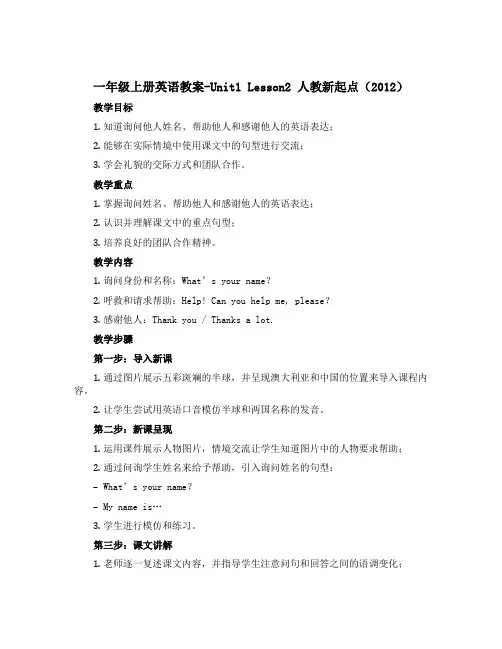
一年级上册英语教案-Unit1 Lesson2 人教新起点(2012)教学目标1.知道询问他人姓名、帮助他人和感谢他人的英语表达;2.能够在实际情境中使用课文中的句型进行交流;3.学会礼貌的交际方式和团队合作。
教学重点1.掌握询问姓名、帮助他人和感谢他人的英语表达;2.认识并理解课文中的重点句型;3.培养良好的团队合作精神。
教学内容1.询问身份和名称:What’s your name?2.呼救和请求帮助:Help! Can you help me, please?3.感谢他人:Thank you / Thanks a lot.教学步骤第一步:导入新课1.通过图片展示五彩斑斓的半球,并呈现澳大利亚和中国的位置来导入课程内容。
2.让学生尝试用英语口音模仿半球和两国名称的发音。
第二步:新课呈现1.运用课件展示人物图片,情境交流让学生知道图片中的人物要求帮助;2.通过问询学生姓名来给予帮助,引入询问姓名的句型:–What’s your name?–My name is…3.学生进行模仿和练习。
第三步:课文讲解1.老师逐一复述课文内容,并指导学生注意问句和回答之间的语调变化;2.辅助学生理解关键句式:–Can you help me, please?–Thank you / Thanks a lot.第四步:合作练习1.分组进行角色扮演,比如演示“需要帮助”的情境,让学生运用刚学的句型互相帮助;2.学生轮流尝试不同角色,加强他们的交际能力和团队合作意识。
第五步:巩固作业1.让学生根据图片和自己的经验,自行编写几个求助和感谢的句子;2.运用课堂学到的英文句型进行表达,并在下一节课上轮流表述。
教学反思这堂课程着重培养了学生在实际情境中的英语表达和交际能力,引导和鼓励学生积极参与团队合作,同时也让他们体会到礼貌的沟通方式。
在教学过程中,将生动有趣的图片与丰富的情境相融合,有助于激发学生的学习兴趣和学习积极性。
同时,通过不同的教学方式和角色扮演,不仅可以提高学生的口语表达能力,还可以培养学生的社交能力和沟通技巧。
小学一年级英语集体备课Unit1 I’m Liu Tao小学一年级英语集体备课Unit1 I’m Liu Tao小学一年级英语集体备课Unit1 I’m Liu Tao小学一年级英语集体备课Unit1 I’m Liu Tao小学一年级英语集体备课Unit 2 Good morning!小学一年级英语集体备课Unit 2 Good morning!小学一年级英语集体备课Unit 2 Good morning!小学一年级英语集体备课Unit 2 Good morning!小学一年级英语集体备课Unit3 This is Miss Li小学一年级英语集体备课Unit3 This is Miss Li小学一年级英语集体备课Unit3 This is Miss Li小学一年级英语集体备课Unit3 This is Miss Li小学一年级英语集体备课Unit4 Is this a teddy?小学一年级英语集体备课Unit4 Is this a teddy?小学一年级英语集体备课Unit4 Is this a teddy?小学一年级英语集体备课Unit4 Is this a teddy?小学一年级英语集体备课Project 1 A play小学一年级英语集体备课 Project 1 A play小学一年级英语集体备课Unit5 A cherry,please小学一年级英语集体备课Unit5 A cherry,please小学一年级英语集体备课Unit5 A cherry,please小学一年级英语集体备课Unit5 A cherry,please小学一年级英语集体备课Unit 6 Look at my balloon小学一年级英语集体备课Unit 6 Look at my balloon小学一年级英语集体备课Unit 6 Look at my balloon。
苏教牛津版一年级上册英语Unit 1 Hello一、教学内容:牛津小学英语1A Unit1 Hello二、教材分析:本单元的主要教学内容是“问候”和“自我介绍”。
在教学中教师要多创设一些与学生生活接近的场景,让学生在实际情景中学会这些日常用语,并养成经常使用英语问候语的习惯。
教学过程中,要积极引导学生听懂、会说本单元中出现的单词和句子,帮助他们准确、熟练、流畅地演唱本单元的歌曲。
三、学情分析:本节课内容很少而且简单,学生对于认识新朋友很感兴趣,所以人物很快就认识了,但是孩子对中国小孩的名字很容易就记得,而外国的Hellen却是练习很多才记得,发音也是个难点。
对于问候语学生能够见到同学老师说出Hello ,Hi。
估计长久的说才能形成习惯。
四、教学目标要求:1.能听懂、会说日常问候语Hello!Hi!要求发音准确、语调自然。
2.能听懂他人使用I`m…介绍自己的名字,同时能使用I`m…介绍自己的名字,发音准确。
3.能根据所听到的名字,正确辨认出第一单元中出现的四个人物Su Hai, Wang Bing, Helen,Mike的形象,能看图说出这四个人物的名字,发音准确。
4.会唱歌曲Hello。
五、教学重点、难点、疑点分析:能听懂他人使用I`m…介绍自己的名字,同时能使用I`m…介绍自己的名字,发音准确。
六、教学准备:多媒体、图片、单词卡片七、课时安排:5课时第一课时教学目标:能够认识三个人物,见面会用Hello,Hi 和别人打招呼。
教学过程:Step1 Warming UpT :Class beginsSs :Stand up!T :Good morning ,class。
Ss :Good morning ,teacher。
T :Sit down,please!Step2 Presentation由学生上课的坐姿,来引入新人物教学。
学生端正坐好,乘此机会表扬坐的好的同学,给他们介绍新朋友。
T :小朋友坐的真好,老师决定给大家介绍几个新朋友,大家想认识他们吗?Ss:想T :想知道他叫什么名字吗?想知道他们长什么样吗?Ss:想T :老师从书中慢慢抽出头饰,先露出头发,依次眼睛,鼻子,嘴巴,整个象头像。
一年级上册英语教学设计-unit 1 School6∣人教新起点教学目标知识与技能目标•学习新单词:school, classroom, teacher, student, desk, chair•学习重点句型:This is my school. The teacher is in the classroom.过程与方法目标•培养学生的听、说、读、写四种语言技能•通过师生互动、听说训练、游戏活动等多种形式提高学习兴趣•在教学过程中引导学生自主学习、合作学习、交流学习,培养终身学习能力情感态度与价值观目标•培养学生成为自主学习者,增强学习兴趣和自信心•帮助学生树立正确的学习态度和价值观念•通过教学活动增强学生的团队合作能力和集体荣誉感教学重点•学习新单词:school, classroom, teacher, student, desk, chair•学习固定句型:This is my school. The teacher is in the classroom.教学难点•让学生能够熟练掌握新单词,准确运用固定句型表达•通过听说训练让学生形成英语思维方式教学建议词汇学习通过多媒体教学方式将单词图像、音频进行呈现,让学生看图听音的形式学习单词,并且通过说出单词、配对游戏、填空练习等方式进行巩固。
句型学习先进行听力训练,让学生理解句子表达的意思,然后进行师生互动,通过问答、模仿等方式使学生熟练掌握句型并能够准确运用。
语言实际运用在学习新单词和句型后,通过分组进行角色扮演游戏等活动,让学生在实际的场景中使用所学语言,提高语言运用能力。
教学过程导入与热身•播放英文童谣《ABC Song》•让学生跟唱,感受英文语言的魅力。
学习新单词1.播放新单词的图像及音频,并呈现单词字母组合。
2.以图片为依据,领读单词,并在黑板上进行书写教学。
3.进行贴图配对、听写等各种练习。
学习句型1.播放句子的音频,并让学生跟读。
Module 1 Unit 1 Hello (教学设计) 外研版(一起)英语一年级上册一、教学目标知识与能力1.学习本单元的基本问候语句及简单的自我介绍。
2.理解被问候语和自我介绍的基本意义。
3.认识并掌握几个英语字母。
4.初步了解英语书写的顺序。
5.能够在学习环境下自然地说出问候语句。
6.能够按照书写顺序正确地书写字母。
情感态度与价值观1.通过互相问候的方式,建立良好的师生之间、同学之间的关系。
2.促进小学生对英语学习的兴趣,初步培养英语学习的兴趣和意识。
3.了解不同国家、地区和文化的问候方式, 学会尊重其他文化差异。
二、教学重点与难点教学重点1.掌握基本问候语,例如 Hello, Hi, Good morning等。
2.理解被问候语和自我介绍的意义,例如问候对方的健康、问候对方的身体状况,以及向对方自我介绍自己的名字和国籍等。
教学难点1.学生掌握英语字母书写的顺序,例如大写字母 A 和小写字母 a。
2.鼓励学生在学习环境下自然地说出问候语句。
三、教学资源1.外研版(一起)英语一年级上册教材。
2.电子白板、投影仪等教学设备。
四、教学过程Step 1:导入新课程1.让学生欣赏有关英语问候语的视频或歌曲。
2.鼓励学生参与,大声朗读并唱出问候语句。
Step 2:呈现新课内容1.呈现单元主题单词“Hello”。
2.询问学生知道哪些问候语。
3.介绍基本问候语 Hello。
4.向学生展示范例对话,引导学生了解 Hey 和 Good morning。
Step 3:集中学习1.鼓励学生模仿一起教学资料中的范例对话,练习与同学和老师打招呼的方法。
2.让学生跟随教师的提示说出 Hello 和 Goodbye。
3.学习字母顺序,书写大写字母A和小写字母a。
Step 4:小组合作1.将学生分组。
2.分别使用基本问候语以及自我介绍来打招呼。
Step 5:实践扩展1.让学生自由发挥,使用英语问候语来开展小组活动,例如进行简单的角色扮演。
北京版小学英语一年级Unit1第一课教案一、教学目标•学生能够听懂、会说、会读、会写单词apple、banana、orange、grape以及词语Hello!、My name is•学生能够正确使用上述单词和词语进行简单的英语对话•学生能够感受到英语学习的趣味性和实用性二、教学重难点1.教学重点:–苹果(apple)、香蕉(banana)、橘子(orange)、葡萄(grape)等单词及词语Hello!、My name is的读、写、说。
2.教学难点:–调动学生积极性,使其主动参与到英语教学中。
三、教学方法1.形象直观法:通过PPT、图片等多种形式向学生展示物品、单词和句子,使学生能够更直观地了解和记忆单词、句子的用法。
2.情景导入/模仿法:通过模仿老师的发音和动作、采用问答式教学或竞赛形式,培养学生的英语听力、口语和阅读能力。
3.师生互动法:教师通过手势、表情和语音引导学生积极参与,激发学生对英语学习的兴趣。
四、教学过程1.学前准备–教师先给学生出示一些图片,如苹果、香蕉、橘子、葡萄等水果的图片,根据图片让学生快速说出单词。
2.自学环节–将图片展示在课桌上,让学生根据图片的内容,说出相应的单词,练习正确的发音。
3.教师讲解–教师讲解每个单词的发音和意思,并让学生跟读。
4.情景模拟及交流–教师和学生一起模拟英语对话,如:教师:Hello!学生:Hello!教师:What’s your name?学生:My name is Tom.教师:Nice to meet you.学生:Nice to meet you, too.–学生可以按照上述对话内容自己编写新的对话,并在班级中交流。
5.温故知新–教师可以反复让学生念、写、画单词,温故知新,夯实单词记忆。
6.结束–教师总结本课的重点和难点,巩固学生的学习成果。
五、课后作业•学生可以通过绘画、作文等形式巩固单词的意思和用法。
并将图片和作品展示在班级中。
六、教学反思•通过教学实践,发现学生的英语学习兴趣大,他们能够非常高效的记住每个单词,并可以用起来。
新修订小学阶段原创精品配套教材Unit 1教材定制 / 提高课堂效率 /内容可修改Unit 1教师:风老师风顺第二小学编订:FoonShion教育Unit 1unit 1teaching aims:(1)using imperatives to give simple instructions.(2)using formulaic expressions to greet people.(3)using nouns to identify common classroom objects.(4)using model verb “can” to express abilities.(5)lean an english song.teaching schedules:5 periodsperiod 1teaching aimsusing imperatives to give simple instructions.teaching pointslisten and act. e.g. stand up, please.teaching difficultiesask pupils to speak and act themselves.teaching aidsmultimedia, cassetteteaching procedurespre-task preparation1.t: class begins. p: stand up. t: good morning, boys and girls .p: good morning, april. t: sit down, please.2.repeat sit down please. stand up, please. ask the class to do the actions. then play a game of quick response, teacher says: boys stand up or girls sit down, see who is better.while-task procedure1.show the picture with a boy sitting on the chair, and elicit “sit down”. let ss response to the order. let students read it one by one. correct the pronunciation.2.use the same method to teach “stand up”. look, the boy isstanding up.3.to elicit “stand up, please.” let students read it one by one. correct the pronunciation.4.play a game to practice these two orders. let boys and girls do theactions and go on a competition. and see which team wins. boys and girls, let’s play a game, i say you do. after playing once, let a students to be a teacher, try to say the requirement.5.quick response. teacher gives order and ss do the action together.6.read a rhyme.up, up, stand up. down, down, sit down. up, up, down, down. up, up, down. when say this rhyme, do the action.7.let ss listen to the tape. ask the ss to listen and point to the pictures with their fingers, and read.8.say “close your book”. do the relevant action, and let ss understand. let students read it.9.show the picture “close your book”, and let ss practice.10.practice “close…” let all the students shout, xxx, close the door! then the student who is named xxx should close the door. teacher can change “door” into “window, book…”11.let one capable student do the action and elicit “open your book”. let students read it.12.practice “open…”let all the students shout, xxx, open the door! then the student who is named xxx should open the door. teacher can change “door” into “window, book…”13.show the picture “open your book”. ask the class to do the action.14.say a rhyme: o, o, open your book, c, c, close your book.15.a competition between boys and girls. t: close your book. t: boys, stand up, please. girls, open your books.post-task activity1.let group of 4 to practice and show themselves in front of the class.2.play a game: class is over. (practice)homeworkspeak and act.period 2teaching aimsusing formulaic expressions to give people.using formulaic expressions to ask how someone is, and respondingteaching pointslearn dialogue: how are you? fine, thank you.learn greeting: good morning.teaching difficultiesask how someone is and responding.teaching aidscassette, multimedia.teaching procedurespre-task preparation1.listen and do the actions. t: stand up, please. sit down, please.open your book. close your book.2.say good morning to ss, and see their response.while-task procedure1.show a picture, tell students the boy is baby, and the woman is mum, first let them read these two words. then let them guess what will they say. some good students can say: good morning. to elicit “good morning”.2.stand in front of a student and say good morning xxx. let the student answer good morning teacher.3.repeat with other students. greet each other. ask one student to greet with teacher, then ask one pair of students to come to the front, and greet each other.4.show a picture of the sun, tell students it’s in the afternoon and it’s in the evening, to elicit good afternoon and good evening.5.say good morning and let ss answer good morning. then teacher say “good afternoon, children.” see if they can answer “goodafternoon teacher.”6.hold a competition to consolidate. show a picture of a lion and a rabbit. then to imitate them. pay attention to the intonation of these two animals. group 1 say good morning, group 2 say good afternoon, group 3 say good evening.7.making a dialogue: good morning, good morning. how are you? see if the good students can answer: fine, thank you.8.show the picture how are you. and let some capable ss to answer fine, thank you.9.practice in pairs “how are you? b: fine, thank you.”10.introduce the other answers: just so so. not very well.post-task activity1.do a dialogue with the greetings learned in the class.2.play a game. s1: how are you? s2: fine, thank you. find friends in the classroom following the music “good morning”.homework:listen and respond.period 3teaching aimsusing nouns to identify common classroom objects.teaching pointlearn words: book, pen, pencil, bag, ruler, rubber.teaching difficultiespronounce words properly.teaching aidscassette, multimedia.teaching procedurespre-task preparation1.do the actions, e.g. stand up, please. play a game: i say you do. this time i will ask a students to be teacher. and he should say: stand up. sit down.2.chair drill around the class. good morning. how are you? fine, thank you. then ask students to go around .the class to find his/her good friend to greet.while-task procedure1.t: what can you see in the classroom? (hold up a pupil’s book.) look, this is a book. read: book. t: have you a book? (the pupils hold up their books) p: book. read it one by one.2.ask what it is, and let ss answer. if the pupil is right. all the pupils clap their hands. yes. if wrong then say the right word.3.t: is this a book? point to the pencil. students will say no. then i will tell them it’s a pencil. read: pencil. t: have you a pencil? (the pupils hold up their pencils) p: pencil. read it one by one: p, p, pencil4.t: is this a pencil? point to the pen. students will say no. then i will tell them it’s a pen. read: pen. t: have you a pen? (the pupils hold up their pens) p: pencil. read it one by one: p, p, pen 5.ask students to look at a pencil and a pen. play a game, quick response. help them to distinguish these two words.6.show the sentence: i can see _____. let students say the words they have learned.7.(the same)teach: ruler, rubber and bag, desk.8.show the pictures. t: point to the ruler. point to the rubber. let ss read the words. match the pictures with the right words.9.missing game. let ss tell which stationery is missed.10.listen to the tape, and read the new words after the tape.post-task activity1.guessing game: t: what’s on the desk? p: bag. then let ss guess what’s in the bag.2.activity. let ss show their stationery on the desk and say the word. say show me your ruler, and ask ss hold up the ruler, and repeat ruler.homework:read the words.period 4teaching aimsusing model verb “can” to express abilities.using formulaic expressions to indicate sharing.using nouns to identify common classroom objects.teaching pointslearn the rhyme. learn word paperteaching difficultiespronounce correctly words: paper.express abilities: i can see.express sharing: for you and me.teaching aids:cassette, multimedia.teaching procedurespre-task preparation1.do the actions. stand up, please. sit down, please. open your book. close your book. clap your hands. stamp your feet. come here, please. go back to your seat.2.read the words together. t: what’s this? p: book.while-task procedure1.learn new word sentence what can you see? i can see… show a piece of paper, and ask what can you see? let ss follow me i cansee a pencil.2.discriminate between two words. t: this is paper (hold up it) t: this is a pencil. (hold up it) read them several times.3.show some other stationery and let ss practice more using dialogue in pairs.4.show the pictures and let ss practice while looking at the pictures …, i can see.5.say a pencil and a rule and show the two things. let ss chose two things to practice … and ….6.give something to a student and say this is for you. let ss practice in line.7.read the paragraph in groups and hole a competition.8.the teacher acts it. let them understand it. repeat paper, a pencil i can see. paper, a pencil for you and me.9.the same to teach: a ruler. a rubber i can see. a ruler. a rubber for you and me.post-task activity1.listen to the tape.2.ask pupils read the rhyme. act out.homeworkrepeat the rhyme.period 5teaching aimsusing formulaic expressions to greet people.using simple present sense to indicate habitual actions.teaching pointslearn the song.teaching difficultiessimple present tense. i take my bag and book to school.teaching aidscassette, multi-media.teaching procedurespre-task preparation1.do the actions. stand up, please. sit down, please. open your book. close your book. clap your hands. stamp your feet. come here, please. go back to your seat.2.say a rhyme learned in last class.while-task procedure1.greeting each other. good morning, a. good morning b.2.teach word, teacher. (point myself) t: i’m a teacher. let ss repeat: teacher.3.say i take a pencil, and do the action.4.teach word school. show a picture of school. let ss say my school. say to school.5.(teacher act and say). t: i take my bag and book to school.6.i take my bag and book, my bag and book to school.7.listen to the tape.8.sing after the tape.post-task activitysing and act the song.homeworksing a song .FoonShion教育研究中心编制Prepared by foonshion Education Research Center。